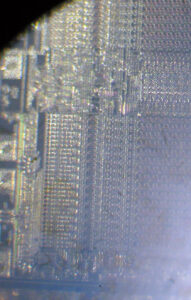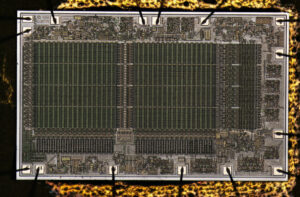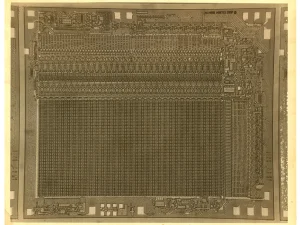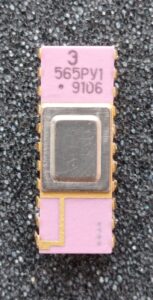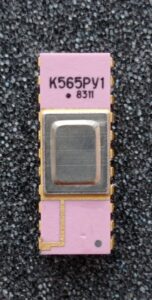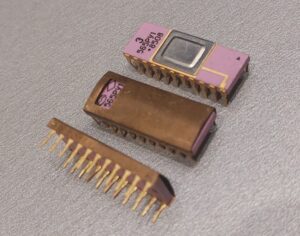The First Mass Produced DRAM of the Soviet Union
In 1966, American engineer and inventor Robert Dennard invented dynamic RAM cells – single-transistor cells, each bit of information is stored in the form of an electric charge of a capacitor. By that time, MOS technology was already capable of creating capacitors. The presence or absence of a charge on a capacitor represents one or zero bits of information. And the transistor can control the recording of the charge into the capacitor. At the time, Dennard was working on a six-transistor memory cell, so he could only devote his spare time to his new idea. After figuring out the intricacies of writing charge into a capacitor using a transistor and then reading it back through the same transistor, Dennard and IBM applied for a patent for single-transistor dynamic random-access memory.
However, the first commercially available dynamic memory chip, the 1103, released by Intel in October 1970, used three transistors per cell and separate lines to write and read data. A single-transistor circuit requires a sophisticated signal amplifier to read the data. It was impossible to implement such an amplifier on a chip with the technology available at that time. At the end of 1971, the 1103 became the best-selling semiconductor chip in the world. By 1972, 14 of the 18 mainframe manufacturers in the U.S., Europe, and Japan were using semiconductor memory instead of magnetic core memory. The first commercially available computer, the HP9800, was designed using the Intel 1103.
The first truly mass-produced dynamic memory chip in the USSR was the 565RU1, a random-access RAM with a capacity of 4096 bits and a 4096 X 1 organization. It is believed that the prototype for the 565RU1 was the 2107A chip released by Intel at the turn of 1973-74. There is some similarities in layout to the 2107A, but it certainly is not a direct copy.
The chip is comparable in technical characteristics to analogues TMS4060 from Texas Instruments and MM5280 from National Semiconductor. Therefore, the question of which of the chips was chosen for copying remains open. The Soviet chip, like its Western counterparts, had a three-transistor memory cell.
It was in this circuitry that it was produced for many years, although the same 2107A was replaced within a year after the start of production by the 2107B chip, which already had a single-transistor memory cell.
It is generally accepted that the 565RU1 chip was developed in 1975, the first samples were obtained in 1976, and engineering samples (ОП in Russian) were produced at Angstrem until the fall of 1977.
 |
 |
Engineering samples. The numbers after the letter A may indicate the number of the experimental batch.
The chip had three types (denoted by the letters “A”, “B” and “V”), differing in the write cycle time. The first chips produced at Angstrem were marked with letters. Subsequently, the marking of the chips was as follows: instead of the letter “A” there was one dot, instead of “B” there were two dots, instead of “V” there were three dots.
In addition to Angstrem, the chip was produced at several other microelectronics enterprises of the USSR, such as Mezon, Alpha and Exciton.
 MEZON
MEZON
The production company “Mezon” was founded in Chisinau in 1969. It was one of the five largest microelectronic enterprises of the former USSR for the production of integrated circuits, with a production volume of more than 130 million units per year.

Working at Mezon was prestigious, and the salaries of the workers, even without higher education, were not small for those times. However, the fate of the enterprise, as well as the fate of many enterprises in Moldova after the collapse of the USSR, turned out to be sad. After several unsuccessful attempts to repurpose the company, the Chisinau Mezon with branch offices was sold in 2008 to a Singaporean company for the symbolic sum of MDL 92 Million (US$ 9 Million).
 |
 |
Metal ceramic packages, in which the chips were produced, are quite expensive. It was at Mezon that an attempt was made to produce 565RU1 chips in a cheaper case, especially since the production of analogues had long been established in the West.
 ALPHA
ALPHA
In 1959, the Semiconductor Devices Plant began to operate in Riga, in 1962 the Riga Research Institute of Microdevices was opened, first the Design Bureau, and since 1966 a full-fledged institute with a factory. In September 1971, the Riga Semiconductor Devices Plant and Research Institute of Microdevices with the plant served as the basis for the establishment of the Production and Technical Association “Alpha”.
The basis of the enterprise was made up of the most experienced specialists, many of whom came from Moscow and Leningrad. For many years, Alpha was the leading enterprise of the Ministry of Electronic Industry in the field of analog and analog-to-digital microcircuits, as well as digital signal processors with an analog input/output device. At its peak, in the 1980s, Alpha employed 10,000 people. In independent Latvia, the company quickly collapsed. Those of the younger specialists left for Russia. Nevertheless, the old cadres managed to keep a small enterprise for the production of electronic components.
 |
 |
 |
Alpha DRAM from 1982, 1984 and 1987. Notice the date format switched in 1987 from WWYY to YYWW
 EXCITON
EXCITON
On November 30, 1943, the State Defense Committee of the USSR ordered the People’s Commissariat of the Electrical Industry to organize a specialized plant of radio components for the production of capacitors and resistors. Thus, in the city of Pavlovsky Posad near Moscow, plant No. 175 was founded, which had only 30 employees. By the end of 1945, the plant had 800 employees. In 1947, the Experimental Design Bureau “Exciton” was established at the plant. In 1963, the plant was renamed Pavlovo-Posad Capacitor Plant, and in August 1968 it was renamed Exciton. By 1970, the company completely stopped the production of capacitors and switched to the production of integral-hybrid and hybrid systems. In the 80s of the last century, the company began the production of dies and the assembly of microcircuits, personal computers, and equipment for classrooms.

Elektronika BK-0010 is one of the first 16-bit personal computers in the world. It has been produced at Exciton since 1984.
565RU1 chips produced at Exciton. Date format change in 1986
Despite the drawbacks (an outdated three-transistor memory cell, the need to use a high-voltage CE signal, inverted output data relative to input data), the 565RU1 chip was widely used. The screen RAM of the Elektronika 15IE-00-013 alphanumeric display is based on these chips.
Two facts related to Elektronika 15IE-00-013 are interesting.
1. The first version of the Tetris game was written on Elektronika-60 with this display
2. The @ symbol on the screen of this display looks like a dog, which may be the reason why it is called a “dog” in Russian.
The 565RU1 chips were used on the M2 processor board of the Elektronika-60 computer
A device for monitoring and measuring the amplitude and frequency characteristics of radio devices with a digital reading of measured values and reproduction of frequency response on the screen of the X1-53 oscillographic indicator also included these microcircuits.
 |
 |
Amplitude-frequency response meter X1-53 and one of its boards with 565RU1
The 565RU1 was produced until the mid-90s. CNC machines that used the 565RU1 had a much longer actual service life compared to computer equipment.
Other Varieties
The chips came in a few other flavors too, export versions were made, military versions were made, for applications in high radiation environments with shielded chips.
To Be Continued….




